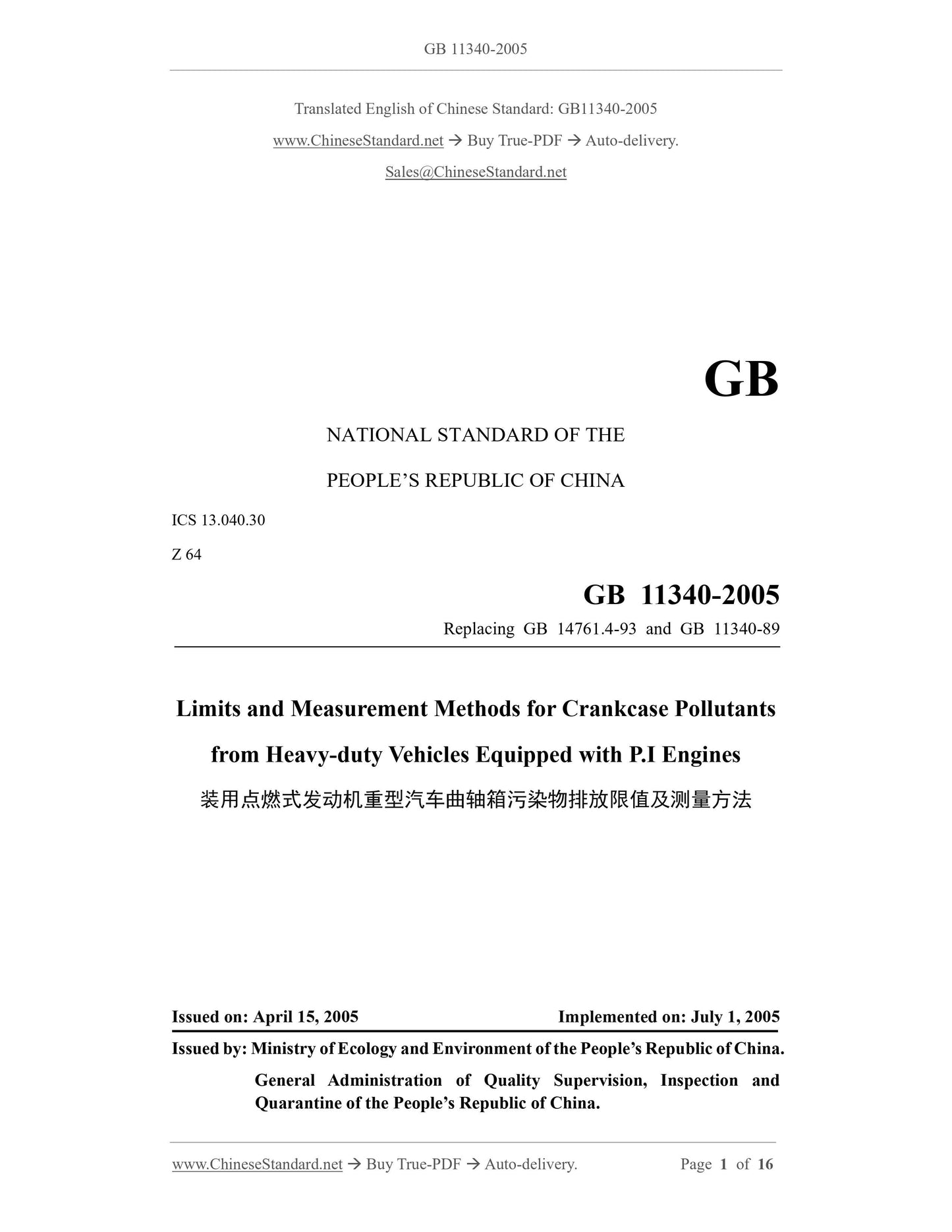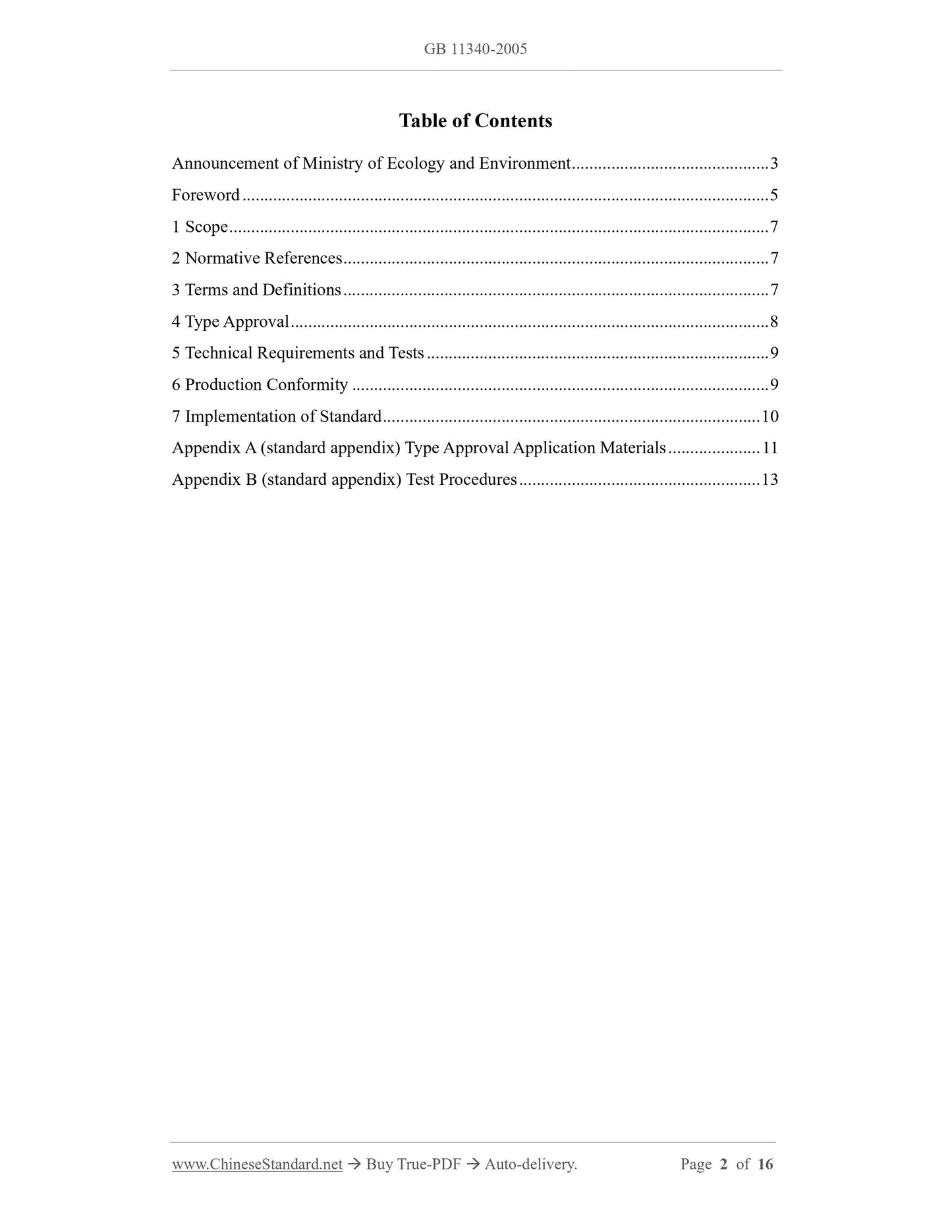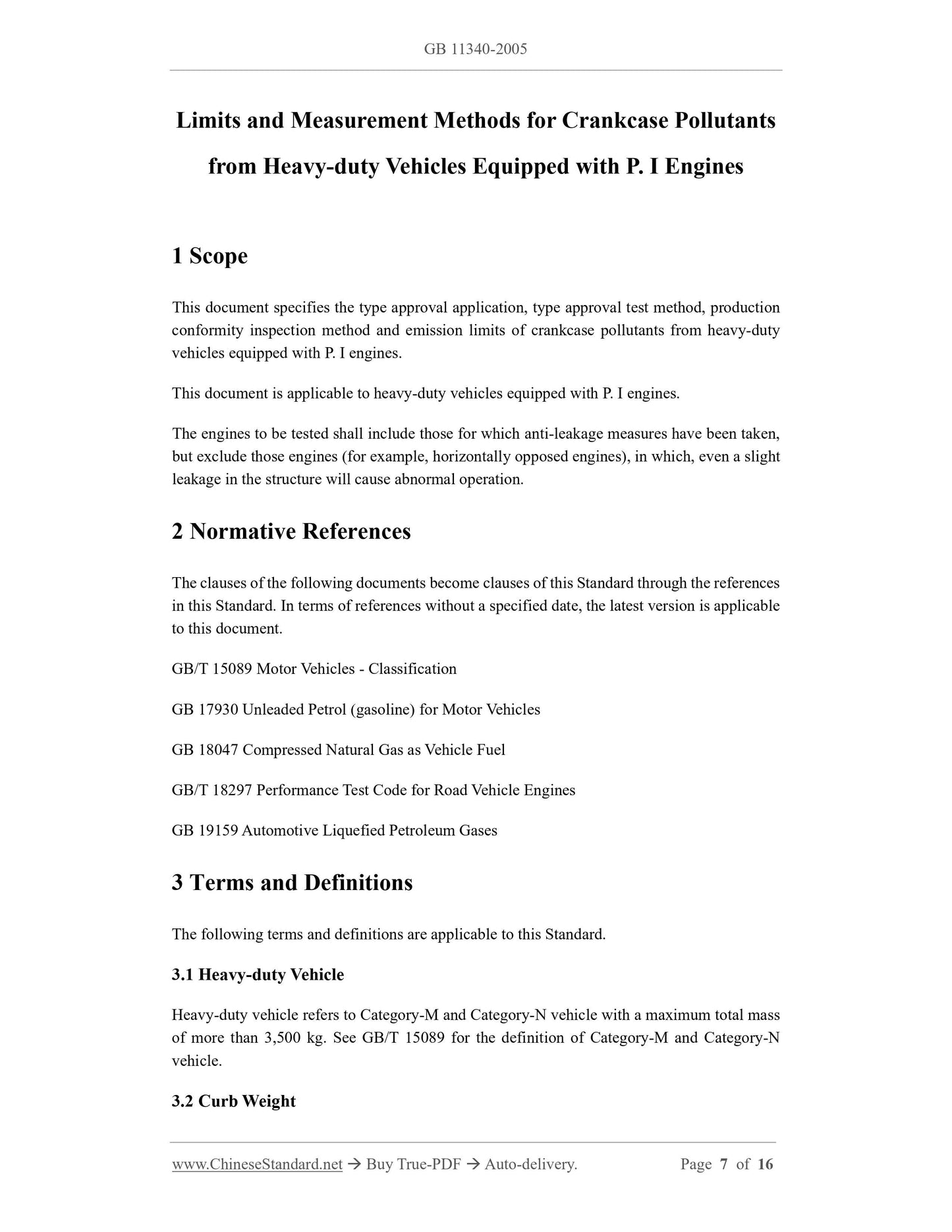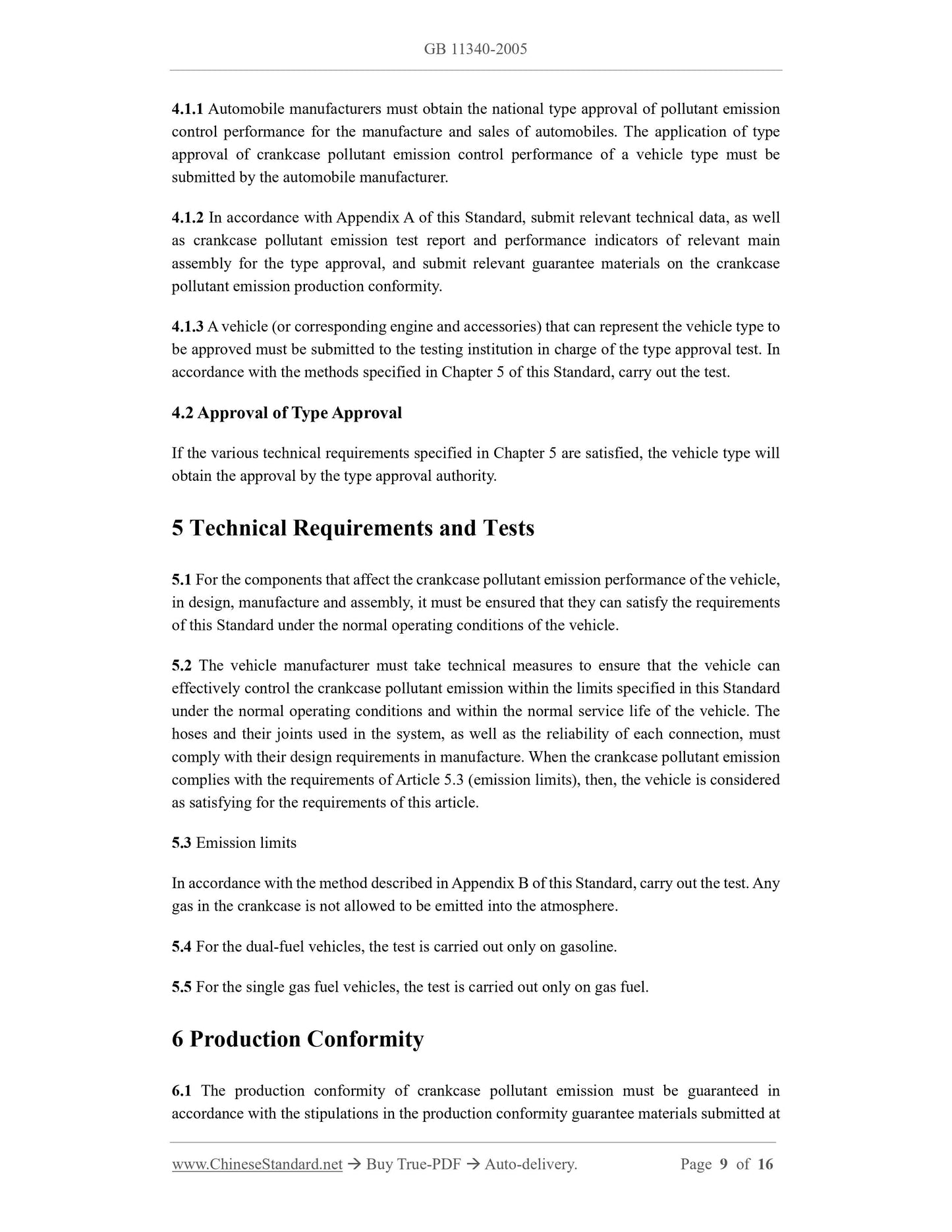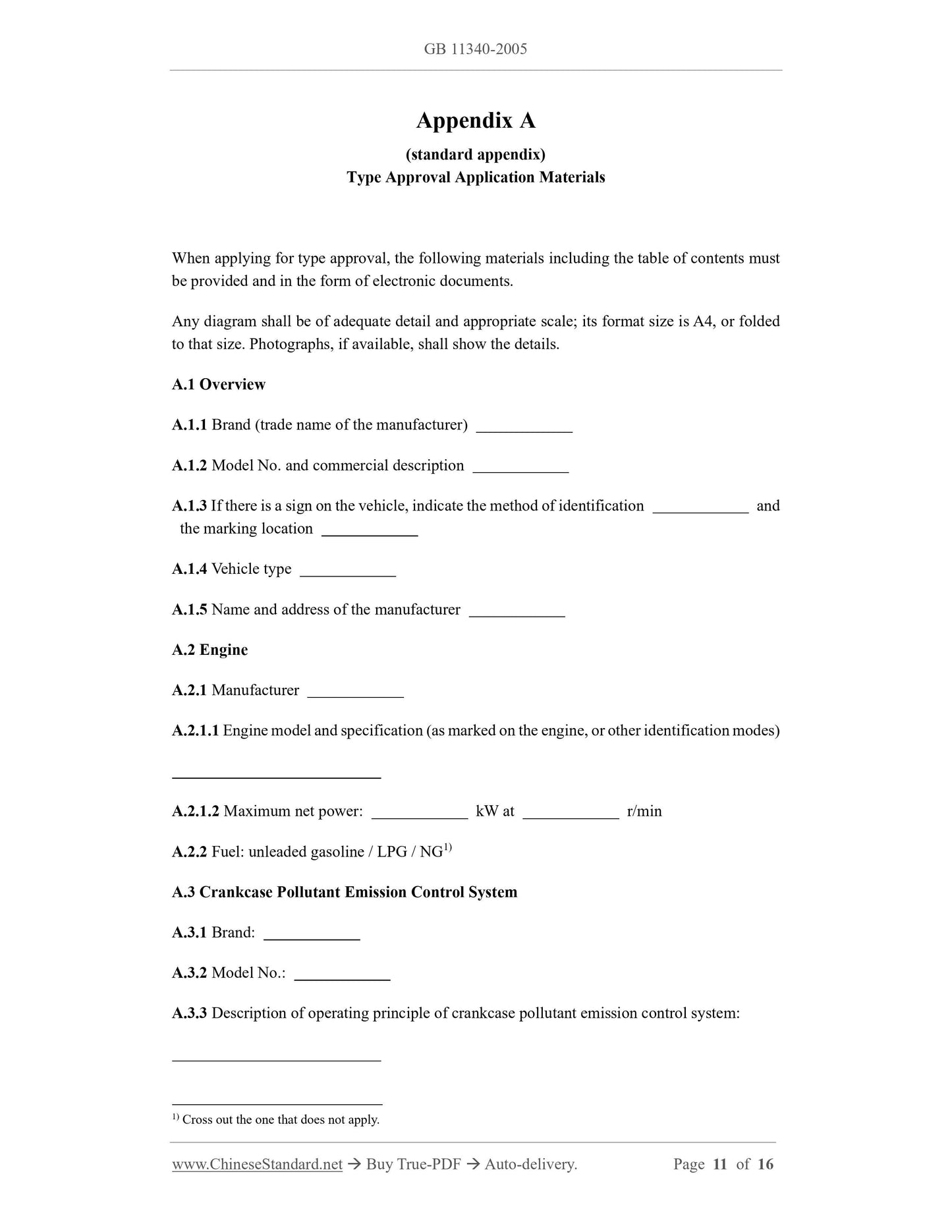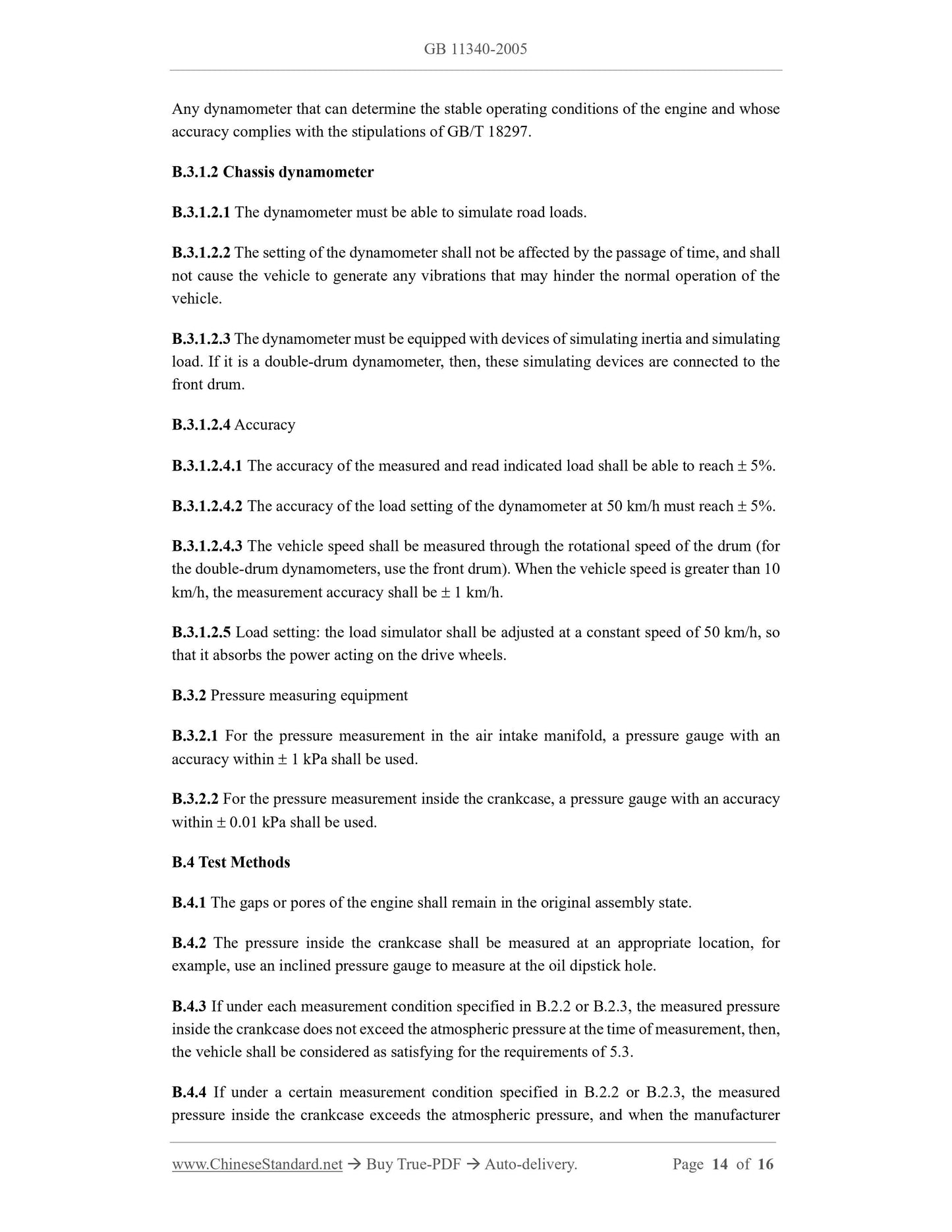1
/
von
6
PayPal, credit cards. Download editable-PDF & invoice in 1 second!
GB 11340-2005 English PDF (GB11340-2005)
GB 11340-2005 English PDF (GB11340-2005)
Normaler Preis
$495.00 USD
Normaler Preis
Verkaufspreis
$495.00 USD
Grundpreis
/
pro
Versand wird beim Checkout berechnet
Verfügbarkeit für Abholungen konnte nicht geladen werden
Delivery: 3 seconds. Download true-PDF + Invoice.
Get QUOTATION in 1-minute: Click GB 11340-2005
Historical versions: GB 11340-2005
Preview True-PDF (Reload/Scroll if blank)
GB 11340-2005: Limit and measurement methods for crankcase pollutants for heavy-duty vehicles equipped with P.I engines
GB 11340-2005
GB
NATIONAL STANDARD OF THE
PEOPLE’S REPUBLIC OF CHINA
ICS 13.040.30
Z 64
Replacing GB 14761.4-93 and GB 11340-89
Limits and Measurement Methods for Crankcase Pollutants
from Heavy-duty Vehicles Equipped with P.I Engines
ISSUED ON: APRIL 15, 2005
IMPLEMENTED ON: JULY 1, 2005
Issued by: Ministry of Ecology and Environment of the People’s Republic of China.
General Administration of Quality Supervision, Inspection and
Quarantine of the People’s Republic of China.
Table of Contents
Announcement of Ministry of Ecology and Environment ... 3
Foreword ... 5
1 Scope ... 7
2 Normative References ... 7
3 Terms and Definitions ... 7
4 Type Approval ... 8
5 Technical Requirements and Tests ... 9
6 Production Conformity ... 9
7 Implementation of Standard ... 10
Appendix A (standard appendix) Type Approval Application Materials ... 11
Appendix B (standard appendix) Test Procedures ... 13
Limits and Measurement Methods for Crankcase Pollutants
from Heavy-duty Vehicles Equipped with P. I Engines
1 Scope
This document specifies the type approval application, type approval test method, production
conformity inspection method and emission limits of crankcase pollutants from heavy-duty
vehicles equipped with P. I engines.
This document is applicable to heavy-duty vehicles equipped with P. I engines.
The engines to be tested shall include those for which anti-leakage measures have been taken,
but exclude those engines (for example, horizontally opposed engines), in which, even a slight
leakage in the structure will cause abnormal operation.
2 Normative References
The clauses of the following documents become clauses of this Standard through the references
in this Standard. In terms of references without a specified date, the latest version is applicable
to this document.
GB/T 15089 Motor Vehicles - Classification
GB 17930 Unleaded Petrol (gasoline) for Motor Vehicles
GB 18047 Compressed Natural Gas as Vehicle Fuel
GB/T 18297 Performance Test Code for Road Vehicle Engines
GB 19159 Automotive Liquefied Petroleum Gases
3 Terms and Definitions
The following terms and definitions are applicable to this Standard.
3.1 Heavy-duty Vehicle
Heavy-duty vehicle refers to Category-M and Category-N vehicle with a maximum total mass
of more than 3,500 kg. See GB/T 15089 for the definition of Category-M and Category-N
vehicle.
3.2 Curb Weight
4.1.1 Automobile manufacturers must obtain the national type approval of pollutant emission
control performance for the manufacture and sales of automobiles. The application of type
approval of crankcase pollutant emission control performance of a vehicle type must be
submitted by the automobile manufacturer.
4.1.2 In accordance with Appendix A of this Standard, submit relevant technical data, as well
as crankcase pollutant emission test report and performance indicators of relevant main
assembly for the type approval, and submit relevant guarantee materials on the crankcase
pollutant emission production conformity.
4.1.3 A vehicle (or corresponding engine and accessories) that can represent the vehicle type to
be approved must be submitted to the testing institution in charge of the type approval test. In
accordance with the methods specified in Chapter 5 of this Standard, carry out the test.
4.2 Approval of Type Approval
If the various technical requirements specified in Chapter 5 are satisfied, the vehicle type will
obtain the approval by the type approval authority.
5 Technical Requirements and Tests
5.1 For the components that affect the crankcase pollutant emission performance of the vehicle,
in design, manufacture and assembly, it must be ensured that they can satisfy the requirements
of this Standard under the normal operating conditions of the vehicle.
5.2 The vehicle manufacturer must take technical measures to ensure that the vehicle can
effectively control the crankcase pollutant emission within the limits specified in this Standard
under the normal operating conditions and within the normal service life of the vehicle. The
hoses and their joints used in the system, as well as the reliability of each connection, must
comply with their design requirements in manufacture. When the crankcase pollutant emission
complies with the requirements of Article 5.3 (emission limits), then, the vehicle is considered
as satisfying for the requirements of this article.
5.3 Emission limits
In accordance with the method described in Appendix B of this Standard, carry out the test. Any
gas in the crankcase is not allowed to be emitted into the atmosphere.
5.4 For the dual-fuel vehicles, the test is carried out only on gasoline.
5.5 For the single gas fuel vehicles, the test is carried out only on gas fuel.
6 Production Conformity
6.1 The production conformity of crankcase pollutant emission must be guaranteed in
accordance with the stipulations in the production conformity guarantee materials submitted at
Appendix A
(standard appendix)
Type Approval Application Materials
When applying for type approval, the following materials including the table of contents must
be provided and in the form of electronic documents.
Any diagram shall be of adequate detail and appropriate scale; its format size is A4, or folded
to that size. Photographs, if available, shall show the details.
A.1 Overview
A.1.1 Brand (trade name of the manufacturer)
A.1.2 Model No. and commercial description
A.1.3 If there is a sign on the vehicle, indicate the method of identification and
the marking location
A.1.4 Vehicle type
A.1.5 Name and address of the manufacturer
A.2 Engine
A.2.1 Manufacturer
A.2.1.1 Engine model and specification (as marked on the engine, or other identification modes)
A.2.1.2 Maximum net power: kW at r/min
A.2.2 Fuel: unleaded gasoline / LPG / NG1)
A.3 Crankcase Pollutant Emission Control System
A.3.1 Brand:
A.3.2 Model No.:
A.3.3 Description of operating principle of crankcase pollutant emission control system:
1) Cross out the one that does not apply.
Any dynamometer that can determine the stable operating conditions of the engine and whose
accuracy complies with the stipulations of GB/T 18297.
B.3.1.2 Chassis dynamometer
B.3.1.2.1 The dynamometer must be able to simulate road loads.
B.3.1.2.2 The setting of the dynamometer shall not be affected by the passage of time, and shall
not cause the vehicle to generate any vibrations that may hinder the normal operation of the
vehicle.
B.3.1.2.3 The dynamometer must be equipped with devices of simulating inertia and simulating
load. If it is a double-drum dynamometer, then, these simulating devices are connected to the
front drum.
B.3.1.2.4 Accuracy
B.3.1.2.4.1 The accuracy of the measured and read indicated load shall be able to reach 5%.
B.3.1.2.4.2 The accuracy of the load setting of the dynamometer at 50 km/h must reach 5%.
B.3.1.2.4.3 The vehicle speed shall be measured through the rotational speed of the drum (for
the double-drum dynamometers, use the front drum). When the vehicle speed is greater than 10
km/h, the measurement accuracy shall be 1 km/h.
B.3.1.2.5 Load setting: the load simulator shall be adjusted at a constant speed of 50 km/h, so
that it absorbs the power acting on the drive wheels.
B.3.2 Pressure measuring equipment
B.3.2.1 For the pressure measurement in the air intake manifold, a pressure gauge with an
accuracy within 1 kPa shall be used. ...
Get QUOTATION in 1-minute: Click GB 11340-2005
Historical versions: GB 11340-2005
Preview True-PDF (Reload/Scroll if blank)
GB 11340-2005: Limit and measurement methods for crankcase pollutants for heavy-duty vehicles equipped with P.I engines
GB 11340-2005
GB
NATIONAL STANDARD OF THE
PEOPLE’S REPUBLIC OF CHINA
ICS 13.040.30
Z 64
Replacing GB 14761.4-93 and GB 11340-89
Limits and Measurement Methods for Crankcase Pollutants
from Heavy-duty Vehicles Equipped with P.I Engines
ISSUED ON: APRIL 15, 2005
IMPLEMENTED ON: JULY 1, 2005
Issued by: Ministry of Ecology and Environment of the People’s Republic of China.
General Administration of Quality Supervision, Inspection and
Quarantine of the People’s Republic of China.
Table of Contents
Announcement of Ministry of Ecology and Environment ... 3
Foreword ... 5
1 Scope ... 7
2 Normative References ... 7
3 Terms and Definitions ... 7
4 Type Approval ... 8
5 Technical Requirements and Tests ... 9
6 Production Conformity ... 9
7 Implementation of Standard ... 10
Appendix A (standard appendix) Type Approval Application Materials ... 11
Appendix B (standard appendix) Test Procedures ... 13
Limits and Measurement Methods for Crankcase Pollutants
from Heavy-duty Vehicles Equipped with P. I Engines
1 Scope
This document specifies the type approval application, type approval test method, production
conformity inspection method and emission limits of crankcase pollutants from heavy-duty
vehicles equipped with P. I engines.
This document is applicable to heavy-duty vehicles equipped with P. I engines.
The engines to be tested shall include those for which anti-leakage measures have been taken,
but exclude those engines (for example, horizontally opposed engines), in which, even a slight
leakage in the structure will cause abnormal operation.
2 Normative References
The clauses of the following documents become clauses of this Standard through the references
in this Standard. In terms of references without a specified date, the latest version is applicable
to this document.
GB/T 15089 Motor Vehicles - Classification
GB 17930 Unleaded Petrol (gasoline) for Motor Vehicles
GB 18047 Compressed Natural Gas as Vehicle Fuel
GB/T 18297 Performance Test Code for Road Vehicle Engines
GB 19159 Automotive Liquefied Petroleum Gases
3 Terms and Definitions
The following terms and definitions are applicable to this Standard.
3.1 Heavy-duty Vehicle
Heavy-duty vehicle refers to Category-M and Category-N vehicle with a maximum total mass
of more than 3,500 kg. See GB/T 15089 for the definition of Category-M and Category-N
vehicle.
3.2 Curb Weight
4.1.1 Automobile manufacturers must obtain the national type approval of pollutant emission
control performance for the manufacture and sales of automobiles. The application of type
approval of crankcase pollutant emission control performance of a vehicle type must be
submitted by the automobile manufacturer.
4.1.2 In accordance with Appendix A of this Standard, submit relevant technical data, as well
as crankcase pollutant emission test report and performance indicators of relevant main
assembly for the type approval, and submit relevant guarantee materials on the crankcase
pollutant emission production conformity.
4.1.3 A vehicle (or corresponding engine and accessories) that can represent the vehicle type to
be approved must be submitted to the testing institution in charge of the type approval test. In
accordance with the methods specified in Chapter 5 of this Standard, carry out the test.
4.2 Approval of Type Approval
If the various technical requirements specified in Chapter 5 are satisfied, the vehicle type will
obtain the approval by the type approval authority.
5 Technical Requirements and Tests
5.1 For the components that affect the crankcase pollutant emission performance of the vehicle,
in design, manufacture and assembly, it must be ensured that they can satisfy the requirements
of this Standard under the normal operating conditions of the vehicle.
5.2 The vehicle manufacturer must take technical measures to ensure that the vehicle can
effectively control the crankcase pollutant emission within the limits specified in this Standard
under the normal operating conditions and within the normal service life of the vehicle. The
hoses and their joints used in the system, as well as the reliability of each connection, must
comply with their design requirements in manufacture. When the crankcase pollutant emission
complies with the requirements of Article 5.3 (emission limits), then, the vehicle is considered
as satisfying for the requirements of this article.
5.3 Emission limits
In accordance with the method described in Appendix B of this Standard, carry out the test. Any
gas in the crankcase is not allowed to be emitted into the atmosphere.
5.4 For the dual-fuel vehicles, the test is carried out only on gasoline.
5.5 For the single gas fuel vehicles, the test is carried out only on gas fuel.
6 Production Conformity
6.1 The production conformity of crankcase pollutant emission must be guaranteed in
accordance with the stipulations in the production conformity guarantee materials submitted at
Appendix A
(standard appendix)
Type Approval Application Materials
When applying for type approval, the following materials including the table of contents must
be provided and in the form of electronic documents.
Any diagram shall be of adequate detail and appropriate scale; its format size is A4, or folded
to that size. Photographs, if available, shall show the details.
A.1 Overview
A.1.1 Brand (trade name of the manufacturer)
A.1.2 Model No. and commercial description
A.1.3 If there is a sign on the vehicle, indicate the method of identification and
the marking location
A.1.4 Vehicle type
A.1.5 Name and address of the manufacturer
A.2 Engine
A.2.1 Manufacturer
A.2.1.1 Engine model and specification (as marked on the engine, or other identification modes)
A.2.1.2 Maximum net power: kW at r/min
A.2.2 Fuel: unleaded gasoline / LPG / NG1)
A.3 Crankcase Pollutant Emission Control System
A.3.1 Brand:
A.3.2 Model No.:
A.3.3 Description of operating principle of crankcase pollutant emission control system:
1) Cross out the one that does not apply.
Any dynamometer that can determine the stable operating conditions of the engine and whose
accuracy complies with the stipulations of GB/T 18297.
B.3.1.2 Chassis dynamometer
B.3.1.2.1 The dynamometer must be able to simulate road loads.
B.3.1.2.2 The setting of the dynamometer shall not be affected by the passage of time, and shall
not cause the vehicle to generate any vibrations that may hinder the normal operation of the
vehicle.
B.3.1.2.3 The dynamometer must be equipped with devices of simulating inertia and simulating
load. If it is a double-drum dynamometer, then, these simulating devices are connected to the
front drum.
B.3.1.2.4 Accuracy
B.3.1.2.4.1 The accuracy of the measured and read indicated load shall be able to reach 5%.
B.3.1.2.4.2 The accuracy of the load setting of the dynamometer at 50 km/h must reach 5%.
B.3.1.2.4.3 The vehicle speed shall be measured through the rotational speed of the drum (for
the double-drum dynamometers, use the front drum). When the vehicle speed is greater than 10
km/h, the measurement accuracy shall be 1 km/h.
B.3.1.2.5 Load setting: the load simulator shall be adjusted at a constant speed of 50 km/h, so
that it absorbs the power acting on the drive wheels.
B.3.2 Pressure measuring equipment
B.3.2.1 For the pressure measurement in the air intake manifold, a pressure gauge with an
accuracy within 1 kPa shall be used. ...
Share
